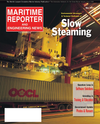
Page 31: of Maritime Reporter Magazine (May 2, 2010)
Read this page in Pdf, Flash or Html5 edition of May 2, 2010 Maritime Reporter Magazine
May 2010 www.marinelink.com 31
Container shipping’s laid up capacity could all be back in service as early as mid-2011 as carriers intensify the prac- tice of slow steaming vessels on long- haul trades. Alphaliner executive consultant Tan Hua Joo said slow steam- ing would address the capacity overhang that is proving such a burden for cash strapped carriers. “On a 10 percent a year growth forecast, by the mid-2011 peak season, we expect all the surplus capacity to be absorbed back into the market,” he predicted. In September last year, as the peak season vanished, there was a surge in the number of shipping lines slowing down their vessels. “Since then we have seen close to 500,000 TEUs of vessel ca- pacity being absorbed by the move to- wards slow steaming,” he said. “On the
Asia-Europe trade most lines are slowing down. From September until now, we have seen a large number of routes on the trade with ships sailing at speeds of 18 knots on average, instead of at the previ- ous 24 knots.”
He said this has helped to take a large chunk of surplus capacity out of the mar- ket. From the Asia-Europe trade the trend has moved to the transpacific, more so on the U.S. East Coast services, the majority of which are employing slow steaming.
With container shipping struggling to recover from its worst crisis, finding a way back to profitability is the top prior- ity. High fuel prices mean high operating costs, and in the absence of large freight rate hikes, cutting the bunker bill makes a lot of financial sense.
According to Lloyd’s Register, slowing a vessel to an engine-friendly 19.8 knots will realize 40 percent savings in fuel.
That means around $1m in fuel savings per voyage, numbers that are hard for shipping line executives to ignore.
Maersk CEO Eivind Kolding said bunker fuel savings more than paid for the addition of an extra ship to a string re- quired to maintain port schedules and services.“As a rule of thumb, if we reduce speed by 20 percent, we can use half our bunker consumption,” he said.
Goh Teik Poh, president of APL South
Asia, said the economics of slow steam- ing were compelling and extended well beyond fuel savings. “Costs can be taken out across the system, from terminal han- dling, feeder services and cargo re-han- dling, in addition to fuel expenses,” he said. With ships being operated more slowly, it is possible to enhance sched- ules. For instance, Goh said, if additional ships were placed in a service, they could call at additional ports and reduce feeder costs.
According to Lloyd’s Register, slowing a vessel to an engine-friendly 19.8 knots will realize 40 percent savings in fuel ... ... that means around $1 million in fuel savings per voyage

 30
30

 32
32
